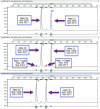Seventy-five years of service: an overview of the College of American Pathologists' proficiency testing program in histocompatibility and identity testing
- PMID: 38169613
- PMCID: PMC10758433
- DOI: 10.3389/fgene.2023.1331169
Seventy-five years of service: an overview of the College of American Pathologists' proficiency testing program in histocompatibility and identity testing
Abstract
The Histocompatibility and Identity Testing Committee offers an overview of the College of American Pathologists' (CAP) Proficiency Testing (PT) program, commemorating its significant 75th anniversary in 2024. The CAP PT program has undergone significant growth and evolution over the years, ultimately achieving Centers for Medicare and Medicaid Services approval. In 1979, CAP's partnership with the American Association for Clinical Histocompatibility Testing marked a pivotal moment, leading to the creation of the first proficiency testing survey in 1980. This laid the foundation for various PT programs managed by the CAP Histocompatibility and Identity Testing Committee, including HLA antibody testing, HLA molecular typing, engraftment monitoring, parentage/relationship testing, HLA disease associations and drug risk, and HLA-B27 typing. Each program's distinctive considerations, grading methodologies, and future prospects are detailed here, highlighting the continual evolution of histocompatibility and identity testing PT to support emerging technologies and evolving laboratory practices in the field.
Keywords: College of American Pathologists (CAP); HLA antibody testing; HLA molecular typing; HLA-B27; disease association; histocompatibility and identity testing committee; monitoring engraftment; proficiency testing.
Copyright © 2023 Sullivan, Gandhi, Gaitonde, Narasimhan, Gendzekhadze, Pandey, Roby, Maha, Kaur, Schiller, McDowell, Smith, Liu and Morris.
Conflict of interest statement
Author GcM was employed by the Laboratory Corporation of America Holdings. Author JS was employed by the Versiti Wisconsin Inc. The remaining authors declare that the research was conducted in the absence of any commercial or financial relationships that could be construed as a potential conflict of interest.
Figures

References
-
- Allen R. W., Eisenberg A., Harrison C., Walker R. H., Young C. T., Zeagler C. T., et al. (2003). Grading of qualitative and quantitative responses in the PI proficiency survey of the College of American Pathologists for mailings in 1997-2000. Int. Congr. Ser. 1239, 825–829. 10.1016/s0531-5131(02)00622-2 - DOI
-
- Antin J. H., Childs R., Filipovich A. H., Giralt S., Mackinnon S., Spitzer T., et al. (2001). Establishment of complete and mixed donor chimerism after allogeneic lymphohematopoietic transplantation: recommendations from a workshop at the 2001 tandem meetings of the international bone marrow transplant registry and the American society of blood and marrow transplantation. Biol. Blood Marrow Transpl. 7 (9), 473–485. 10.1053/bbmt.2001.v7.pm11669214 - DOI - PubMed
Publication types
LinkOut - more resources
Full Text Sources
Research Materials
Miscellaneous

